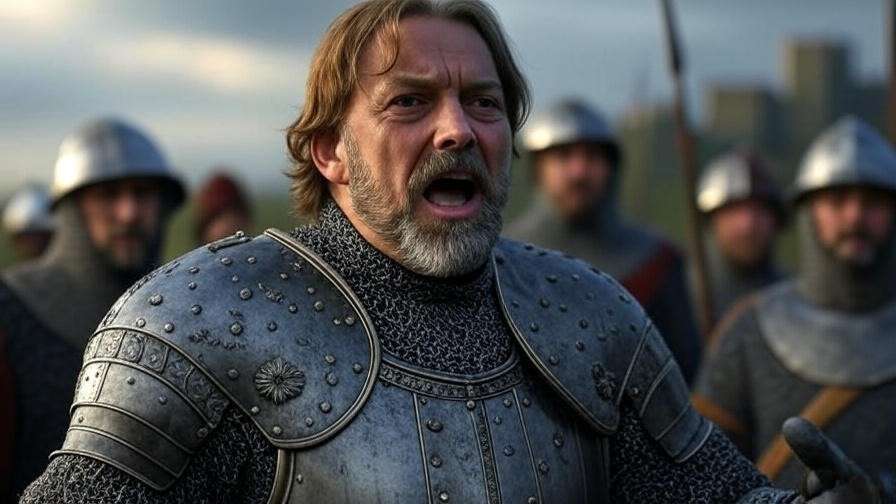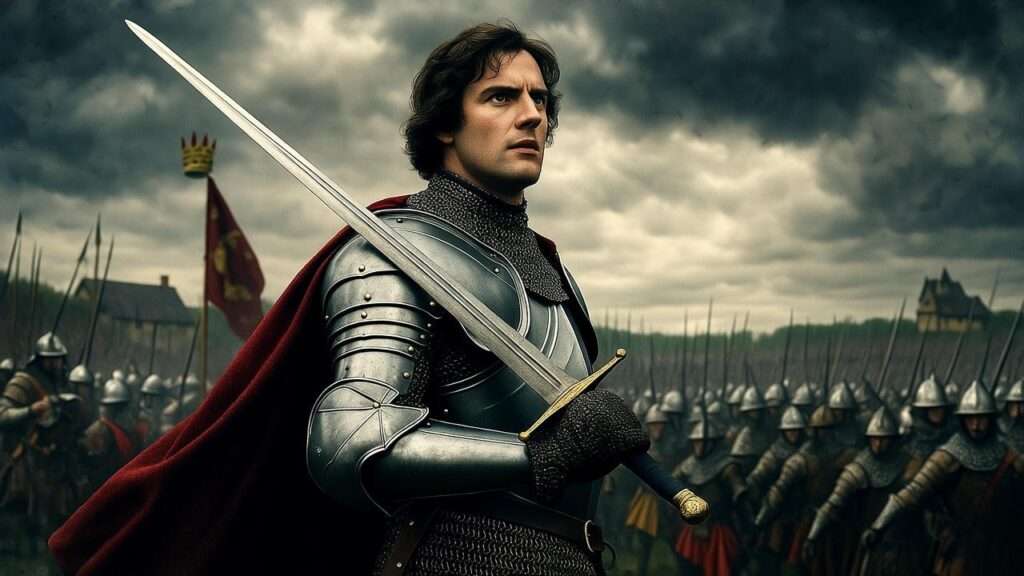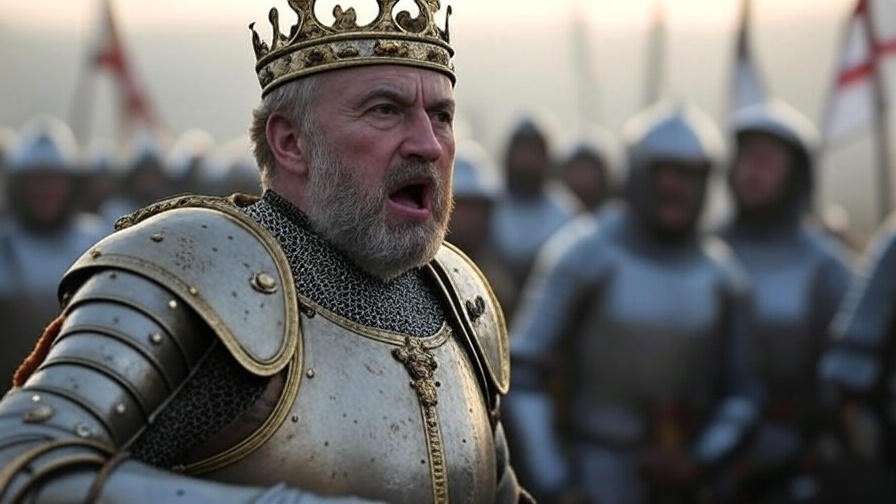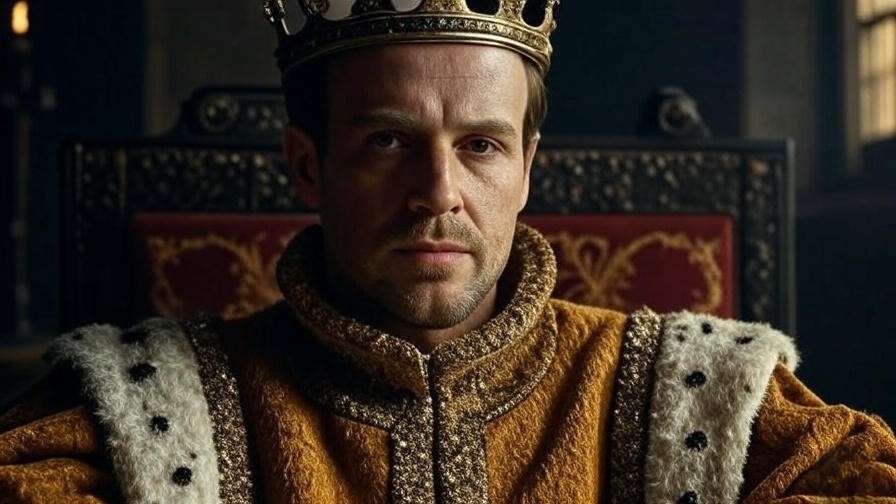Picture a rain-soaked battlefield, the air thick with tension, as a young king steps forward to rally his weary troops with words that echo through history: “We few, we happy few, we band of brothers.” This is the heart of Henry V, William Shakespeare’s timeless masterpiece of leadership, war, and human spirit. For those seeking a Henry V play summary that captures its essence, this article offers a comprehensive guide to the plot, themes, and enduring relevance of the play. As a Shakespeare scholar with years of study and teaching experience, I invite you to explore this epic history play, which continues to inspire students, theatergoers, and leaders alike. From its rousing speeches to its complex moral questions, Henry V offers profound insights into courage, unity, and the cost of power.
In this article, you’ll find a detailed Henry V play summary, in-depth analysis of its themes, historical context, character breakdowns, and practical takeaways for study or performance. Whether you’re a student tackling the text, an educator seeking teaching resources, or a theater enthusiast curious about its modern resonance, this guide is designed to illuminate Shakespeare’s work in a clear, engaging, and authoritative way.
Overview of Henry V by William Shakespeare
Historical Context of the Play
Written around 1599, Henry V emerged during the Elizabethan era, a time when England’s victory over the Spanish Armada (1588) fueled national pride. Shakespeare crafted the play to celebrate English valor while subtly questioning the costs of war. Set during the Hundred Years’ War (1337–1453), it dramatizes King Henry V’s 1415 campaign in France, particularly the Battle of Agincourt. Drawing from Raphael Holinshed’s Chronicles of England, Scotland, and Ireland, Shakespeare blends historical fact with dramatic flair, creating a narrative that resonated with Elizabethan audiences and remains relevant today. The play reflects the era’s fascination with strong leadership and national identity, themes that continue to captivate modern readers.
Significance in Shakespeare’s Canon
Henry V is the final chapter of Shakespeare’s “Henriad,” a tetralogy of history plays (Richard II, Henry IV Part 1, Henry IV Part 2, and Henry V) that traces the rise of the House of Lancaster. Unlike the earlier plays’ focus on political intrigue and personal growth, Henry V shifts to epic storytelling, blending history with elements of tragedy and comedy. Its iconic speeches, like “Once more unto the breach” and “St. Crispin’s Day,” showcase Shakespeare’s rhetorical genius, while its diverse cast—nobles, soldiers, and commoners—broadens its appeal. The play’s exploration of leadership and morality distinguishes it as a cornerstone of Shakespeare’s historical dramas.
Why Henry V Resonates Today
In an era of global conflicts and leadership challenges, Henry V speaks to timeless questions: What makes a great leader? How do we balance duty with morality? Its portrayal of unity amid diversity—seen in the English army’s mix of Welsh, Scottish, and Irish soldiers—mirrors modern calls for collaboration across differences. For students, the play offers rich material for analyzing rhetoric and character development. For theater practitioners, its dynamic staging possibilities inspire creative interpretations. And for general readers, Henry V delivers a gripping story of courage and sacrifice that transcends its historical setting.
Comprehensive Plot Summary of Henry V
Act 1 – The Call to War
The play opens with the Chorus, a narrator who invites the audience to imagine the grand scale of the story, compensating for the “wooden O” of the Globe Theatre’s limited stage. King Henry V, now a mature ruler, faces a decision: should he claim the French throne based on a legal argument presented by the Archbishop of Canterbury? The Dauphin of France’s mocking gift—a set of tennis balls—provokes Henry’s resolve, leading him to declare war. This act establishes Henry as a decisive leader, contrasting with his reckless youth as Prince Hal in the Henry IV plays.
Act 2 – Preparations and Betrayals
As England prepares for war, Henry uncovers a plot by three nobles—Cambridge, Scroop, and Grey—to assassinate him. His swift, merciless response demonstrates his strategic mind and commitment to justice. Meanwhile, comic scenes featuring Falstaff’s former companions—Pistol, Nym, and Bardolph—introduce levity, highlighting the human side of the war effort. The act sets the stage for the French campaign, with the Chorus vividly describing the fleet’s departure for France.
Act 3 – The Siege of Harfleur and Agincourt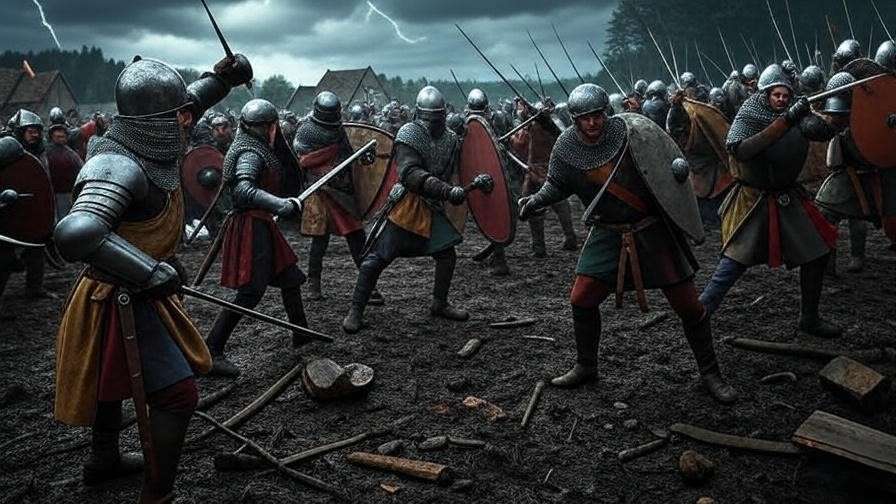
The English army besieges the French town of Harfleur, where Henry delivers the stirring “Once more unto the breach” speech, urging his troops to fight with relentless courage. The town surrenders, but the campaign takes a toll. Later, at Agincourt, the English face overwhelming odds against a larger French army. Henry’s leadership shines as he navigates logistical challenges and boosts morale. The act’s climax is the eve of Agincourt, where Henry disguises himself to mingle with his soldiers, revealing his empathy and inner doubts.
Act 4 – Leadership and Camaraderie
The Battle of Agincourt is the play’s heart, marked by the iconic “St. Crispin’s Day” speech, where Henry inspires his “band of brothers” to fight for glory despite their small numbers. The English achieve a miraculous victory, defying expectations. Henry’s interactions with soldiers like Williams and Fluellen highlight his ability to connect across class divides. However, the execution of Bardolph for looting underscores the harsh realities of war, complicating Henry’s heroic image.
Act 5 – Peace and Union
After Agincourt, Henry negotiates the Treaty of Troyes, securing his claim to the French throne. His courtship of Princess Katherine of France, marked by a charming yet politically charged scene, symbolizes the union of the two nations. The play ends with the Chorus reflecting on the fleeting nature of Henry’s triumphs, as his son, Henry VI, will lose France in future wars. This bittersweet conclusion underscores the cyclical nature of history.
Key Themes in Henry V
Leadership and Kingship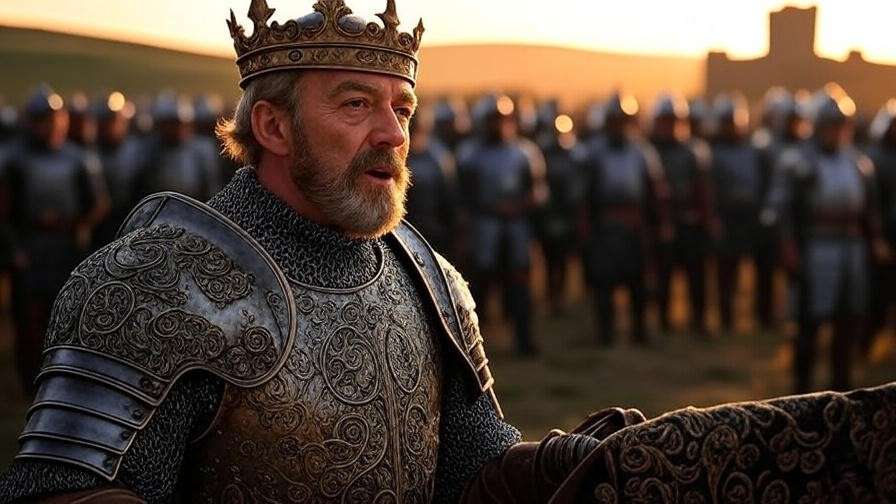
Henry V’s transformation from the wayward Prince Hal to a charismatic king is central to the play. His ability to inspire—through speeches like “St. Crispin’s Day”—reflects a leadership style rooted in empathy, resolve, and strategic thinking. Modern readers can draw parallels to effective leadership traits, such as clear communication and adaptability. Henry’s blend of charisma and pragmatism makes him a compelling study for anyone interested in leadership dynamics.
Patriotism and National Identity
Henry V celebrates English unity while acknowledging diversity through characters like Fluellen (Welsh), Jamy (Scottish), and Macmorris (Irish). The play fosters pride in England’s underdog victory at Agincourt, yet Shakespeare subtly questions blind patriotism by showing war’s human toll. This duality resonates with contemporary discussions about national identity and collective pride in a globalized world.
The Morality of War
Shakespeare presents war as both glorious and devastating. Henry’s victories are heroic, but scenes like the execution of prisoners and the deaths of common soldiers reveal war’s moral complexities. The play invites readers to weigh the costs of ambition against the pursuit of honor, a debate that remains relevant in modern conflicts.
Unity and Brotherhood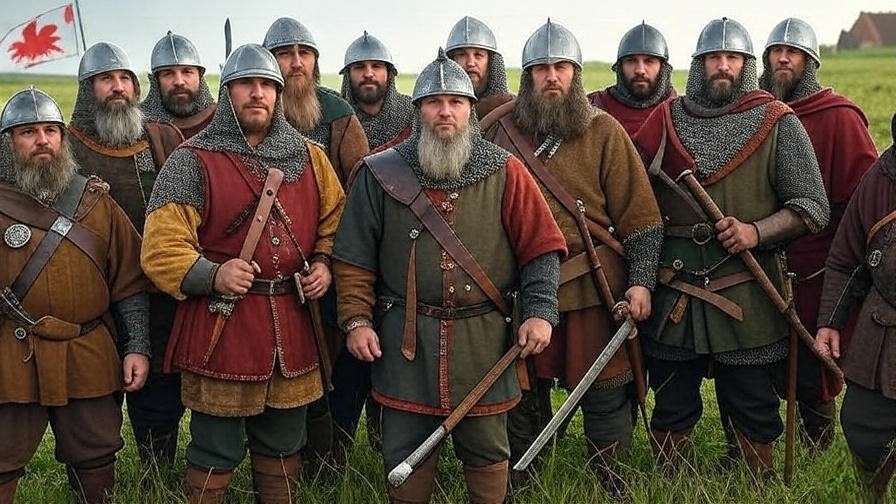
The “band of brothers” motif captures the camaraderie among soldiers, transcending social divides. Henry’s ability to unite his army reflects universal themes of teamwork and sacrifice. This resonates with audiences today, from corporate teams to community initiatives, emphasizing the power of collective effort.
Character Analysis
King Henry V
Henry is a multifaceted figure: a pious Christian, a ruthless strategist, and a charismatic orator. His evolution from the reckless Prince Hal to a disciplined king showcases Shakespeare’s skill in character development. Key moments, like his disguise among soldiers, reveal his humanity, while his harsh decisions, like executing traitors, highlight his pragmatism. His speeches demonstrate rhetorical mastery, blending inspiration with calculated persuasion.
Supporting Characters
The Chorus serves as a narrative guide, enhancing the play’s epic scope. Falstaff’s companions—Pistol, Nym, and Bardolph—provide comic relief while grounding the story in the perspective of commoners. Fluellen, the Welsh captain, embodies loyalty and humor, while Princess Katherine’s language lessons and courtship scene add charm and political nuance. Each character enriches the play’s tapestry.
The Common Soldier
Shakespeare’s portrayal of soldiers like Williams and Bates humanizes the war effort. Their debates with Henry (in disguise) about responsibility and mortality add philosophical depth. These characters make Henry V relatable, showing the universal struggles of duty and survival.
Historical and Cultural Insights
The Real Henry V vs. Shakespeare’s Version
Historically, Henry V was a skilled but ruthless monarch, known for his military prowess and harsh tactics, like executing prisoners at Agincourt. Shakespeare idealizes him as a unifying hero, omitting some of his cruelties to suit Elizabethan patriotism. This artistic choice enhances the play’s dramatic impact but invites critical examination of historical accuracy.
Elizabethan Audience Reception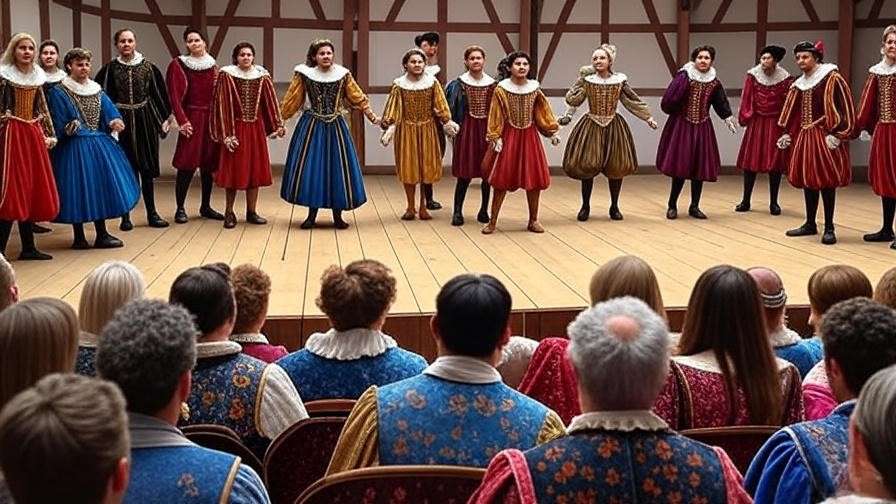
For Elizabethan audiences, Henry V was a patriotic rallying cry, performed at the newly built Globe Theatre. Its celebration of English valor resonated after the Armada victory, while its humor and diverse characters appealed to all social classes. The Chorus’s direct address engaged audiences, making them active participants in the story.
Modern Adaptations and Performances
Henry V has inspired iconic adaptations, from Laurence Olivier’s 1944 film, which boosted wartime morale, to Kenneth Branagh’s 1989 gritty, emotional rendition. Recent stage productions, like those by the Royal Shakespeare Company, emphasize the play’s anti-war undertones. These interpretations highlight its versatility, appealing to diverse audiences through varied lenses.
Why Study Henry V?
For Students and Educators
Henry V is a treasure trove for academic exploration, offering rich material for analyzing Shakespeare’s language, themes, and historical context. Students can dissect Henry’s speeches to study rhetorical devices like anaphora and metaphor, or explore the play’s moral questions, such as the ethics of war. Educators can use the play to spark discussions on leadership, national identity, or the role of theater in shaping public perception. Suggested essay topics include: “Is Henry V a heroic leader or a calculating pragmatist?” and “How does Shakespeare balance patriotism with critique in Henry V?” Pairing the text with historical sources, like Holinshed’s Chronicles, can deepen understanding, while classroom activities, such as staging key scenes, bring the play to life.
For Theater Practitioners
Staging Henry V presents unique challenges and opportunities. The Chorus’s vivid descriptions demand creative solutions to depict epic battles on a limited stage—modern productions often use minimalist sets or multimedia to evoke the “vasty fields of France.” Directors must balance the play’s comedic elements, like Pistol’s antics, with its dramatic weight, such as the Agincourt scenes. Casting Henry requires an actor who can convey both charisma and vulnerability, while supporting roles like Fluellen offer opportunities for vibrant character work. Theater practitioners can draw inspiration from modern adaptations, tailoring the play to highlight contemporary issues like leadership or conflict.
For General Readers
Beyond academia and theater, Henry V offers universal lessons. Its exploration of courage, unity, and the human cost of ambition resonates with anyone navigating leadership roles or personal challenges. The play’s iconic speeches inspire readers to reflect on their own values, while its humor and humanity make it accessible. General readers can engage with Henry V through performances, films, or annotated editions, gaining insights into resilience and camaraderie that apply to everyday life.
Expert Insights and Analysis
Shakespeare’s Use of Language
Shakespeare’s linguistic brilliance shines in Henry V, particularly in Henry’s speeches and the Chorus’s poetic narration. The “St. Crispin’s Day” speech, with its rhythmic iambic pentameter and evocative imagery (“We few, we happy few”), showcases anaphora and emotional appeal, rallying both soldiers and audiences. The Chorus employs vivid metaphors, like the “wooden O,” to bridge the gap between the stage and the audience’s imagination. These linguistic choices elevate the play’s emotional and intellectual impact, making it a masterclass in rhetorical persuasion.
Critical Perspectives
Scholars debate whether Henry V glorifies or critiques war. Critics like Harold Bloom praise its heroic portrayal of Henry, viewing it as a celebration of English valor. Others, like Stephen Greenblatt, highlight its subversive undertones, noting scenes like the execution of prisoners and the soldiers’ skepticism as critiques of war’s morality. This tension invites readers to question whether Henry’s victories justify their costs, a debate that enriches the play’s complexity and relevance.
Symbolism and Imagery
Recurring motifs in Henry V deepen its thematic resonance. The crown symbolizes the burdens of leadership, as Henry grapples with its weight in his soliloquies. Battlefields evoke both glory and destruction, while the “wooden O” of the Globe Theatre represents the power of imagination to transcend physical limits. These symbols, woven into Shakespeare’s language, create a layered narrative that invites multiple interpretations.
Practical Applications and Takeaways
Leadership Lessons from Henry V
Henry’s leadership offers actionable insights for modern contexts:
- Inspire with Vision: Henry’s speeches unite his army by painting a shared purpose, a strategy leaders can use to motivate teams.
- Adapt to Challenges: His ability to pivot from diplomacy to battle reflects strategic flexibility.
- Empathize with Others: His disguised conversations with soldiers show the value of understanding diverse perspectives.
- Balance Ethics and Pragmatism: Henry’s tough decisions, like executing traitors, highlight the need to weigh moral and practical considerations.
These lessons apply to business, community leadership, or personal growth, making Henry V a timeless guide.
How to Engage with Henry V
Readers can experience Henry V in multiple ways:
- Read the Text: Use annotated editions like the Arden Shakespeare or Folger Library for accessible notes and context.
- Watch Adaptations: Explore films like Branagh’s 1989 Henry V or the 2012 BBC Hollow Crown series for visual interpretations.
- Attend Performances: Seek out local or professional productions, such as those by the Royal Shakespeare Company, for a live experience.
- Join Discussions: Engage with Shakespeare communities online or in book clubs to share insights and interpretations.
Tips for Teaching or Presenting Henry V
Educators and presenters can enhance engagement with these strategies:
- Focus on Key Scenes: Highlight the “St. Crispin’s Day” speech or Henry’s disguise scene for in-depth analysis.
- Use Multimedia: Show clips from film adaptations to illustrate staging choices or character portrayals.
- Encourage Debate: Pose questions like “Does Henry glorify war or expose its flaws?” to spark critical thinking.
- Incorporate Activities: Have students perform monologues or create visual storyboards of the Agincourt battle to deepen engagement.
FAQs About Henry V
What is the main message of Henry V?
The play explores leadership, duty, and the complexities of war. While it celebrates Henry’s triumphs, it also questions the moral costs of conflict, offering a nuanced perspective on heroism and sacrifice.
Is Henry V historically accurate?
Shakespeare draws from historical sources but takes liberties for dramatic effect. The real Henry V was a skilled but ruthless leader, and the play omits some of his harsher actions, like mass executions, to emphasize his heroism.
Why is the “St. Crispin’s Day” speech so famous?
Its emotional power, rhythmic cadence, and universal themes of brotherhood and valor make it one of Shakespeare’s most iconic monologues, often quoted in literature, film, and leadership contexts.
How does Henry V fit into the Henriad?
As the final play in the tetralogy, Henry V completes the arc of Prince Hal’s transformation into a mature king, building on themes of legitimacy and leadership from Richard II and Henry IV.
What are the best adaptations of Henry V?
Notable versions include Laurence Olivier’s 1944 film, which emphasizes patriotism, and Kenneth Branagh’s 1989 film, which highlights the gritty realities of war. Modern stage productions, like those by the RSC, offer fresh interpretations.
Henry V is more than a historical drama—it’s a profound exploration of leadership, unity, and the human spirit. This Henry V play summary has unpacked its gripping plot, from the siege of Harfleur to the triumph at Agincourt, while delving into its themes of patriotism, morality, and camaraderie. For students, educators, theater practitioners, and general readers, the play offers timeless lessons and emotional resonance. Whether you’re inspired by Henry’s rousing speeches or moved by the soldiers’ humanity, Henry V invites you to reflect on what it means to lead and unite in the face of adversity. Explore the play through reading, performances, or discussions, and share your favorite moments in the comments below. This Henry V play summary offers Shakespeare enthusiasts a deep dive into its timeless themes and enduring legacy.

